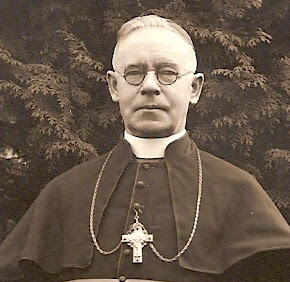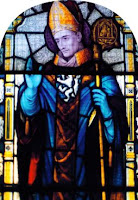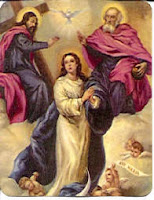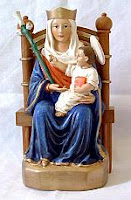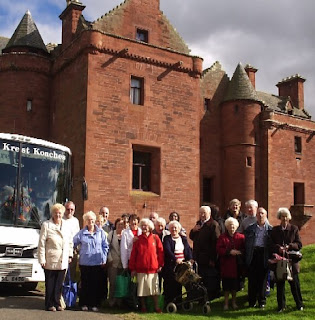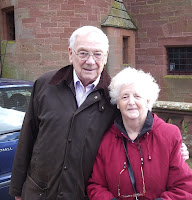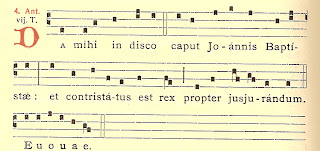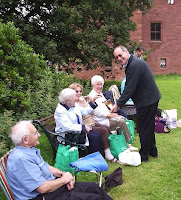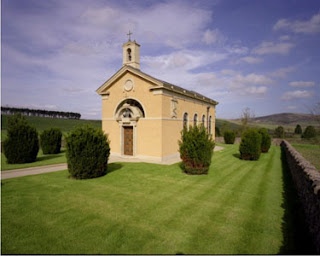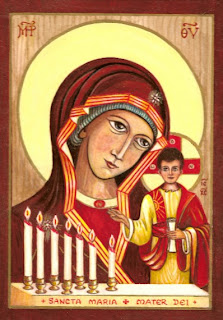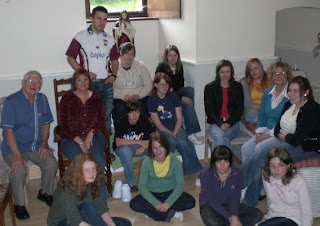
Youth Group Gala Rome Trip.
Preparatory Retreat Nunraw 18 Aug 2007
In the Scottish Borders three Parishes, Melrose, Selkirk & Galashiels have one priest, Fr. John Creanor as PP. The Youth Group from the Holy Trio of Parishes is planning to make the journey to Rome.
I explained to the young folk from Melrose and its environs that when the foundation of Nunraw was begun in 1946 there was talk of adopting the name “New Melrose”. Some new monasteries choose an ancient Cistercian monastery for their title. In fact the young community at Nunraw preferred to begin a new name. Their choice received further affirmation when the history of Nunraw was discovered already had Cistercian roots. As a Grange of the Cistercian convent of Haddington it was known as Nunraw, the NUN’s Row (of buildings).
After their trip to the Holy City they will return and hopefully return to Nunraw for a de-briefing Retreat of all their experiences in Rome.
Feast 24th August Saint Bartholomew
Newman on St Bartolomew’s Vocation
of “quietness without, guilelessness within”,
“not give up our usual manner of life, in order to serve God”
To Mark St Bartholomew’s Day, we had a rather unusual reflection in the Night Office.
It was a gem of insight of John Henry Newman. With so little in the Gospel, there is minimum scope for exegesis but what Newman does beautifully is to catch a glimpse of the character of Bartholomew, and then to draw us into deep waters of quietness and guilelessness.
The passage echoed for me someone’s life long raport to Newman’s teaching. This convert friend was impelled to write a few words in response to a rather crude comment by a Nun saying that Newman was no longer useful.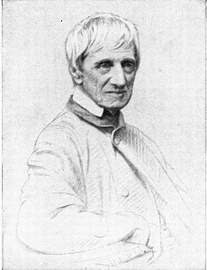
She wrote, “I don't think it's true that "Newman can only be a partial guide for someone living in the nineteen eighties" In 1952 I was 24 and the wife of Naval Chaplain. . . . .
I spent a long time reading Wilfrid Ward's Life of Newman, Faber, and then anything and everything I could find on Newman. It seemed as though he were speaking directly to me, understanding my situation, and most of all understanding my LOVE for the Anglican Church as no Catholic I met could understand it. In the end, my love for my own Church was to be the greatest barrier to my conversion. . . .
It is now the nineteen eighties, much is changed, but I find more relevance in Newman's writings today than I did even then. He made it abundantly clear that the path to Rome and its onward journey was no easy matter. Nor is it”.
From a sermon by John Henry Newman (Parochial and Plain Sermons, volume 2, pp. 335-337)
When Philip told him that he had found the long-expected Messiah of whom Moses wrote, Nathanael (that is, Bartholomew) at first doubted. He was well read in the scriptures, and knew the Christ was to be born in Bethlehem; whereas Jesus dwelt at Nazareth, which Nathanael supposed in consequence to be the place of his birth, - and he knew of no particular promises attached to that city, which was a place of evil report, and he thought no good could come out of it. Philip told him to come and see; and he went to see, as a humble single-minded man, sincerely desirous to get at the truth. In consequence, he was vouchsafed an interview with our Saviour, and was converted.
Now from what occurred in this interview, we gain some insight into St. Bartholomew's character. Our Lord said of him, Behold an Israelite indeed, in whom is no guile! and it appears, moreover, as if, before Philip called him to come to Christ, he was engaged in meditation or prayer, in the privacy which a fig-tree's shade afforded him. And this, it seems, was the life of one who was destined to act the busy part of an apostle; quietness without, guilelessness within. This was the tranquil preparation for great dangers and sufferings! We see who make the most heroic Christians, and are the most honoured by Christ!
An even, unvaried life is the lot of most men, in spite of occasional troubles or other accidents; and we are apt to despise it, and to get tired of it, and to long to see the world or, at all events, we think such a life affords no great opportunity for religious obedience. To rise up, and go through the same duties, and then to rest again, day after day, to pass week after week, beginning with God's service on Sunday, and then to our worldly tasks, so to continue till year follows year, and we gradually get old - an unvaried life like this is apt to seem unprofitable to us when we dwell upon the thought of it.
Many indeed there are, who do not think at all; but live in their round of employments, without care about God and religion, driven on by the natural course of things in a dull irrational way like the beasts that perish.
But when a man begins to feel he has a soul, and a work to do, and a reward to be gained, greater or less, according as he improves the talents committed to him, then he is naturally tempted to be anxious from his very wish to be saved, and he says, "What must I do to please God?" And sometimes he is led to think he ought to be useful on a large scale, and goes out of his line of life, that he may be doing something worth doing, as he considers it.
Here we have the history of St. Bartholomew and the other apostles to recall us to ourselves, and to assure us that we need not give up our usual manner of life, in order to serve God; that the most humble and quietest station is acceptable to him, if improved duly - nay, affords means for maturing the highest Christian character, even that of an apostle Bartholomew read the scriptures and prayed to God; and thus was trained at length to give up his life for Christ, when he demanded it.
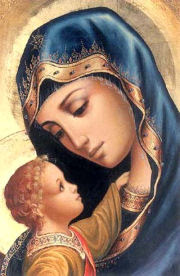 Elizabeth greets Mary, "Blessed is the fruit of your womb", it can be seen as a revolutionary feminist Proclamation. Elizabeth the expectant mother of John the Baptist, Mary the expectant mother of Jesus, leading us, in the most human approach, the birth of the Child Jesus, to the greatest Mystery, to the Incarnate the Son of God.
Elizabeth greets Mary, "Blessed is the fruit of your womb", it can be seen as a revolutionary feminist Proclamation. Elizabeth the expectant mother of John the Baptist, Mary the expectant mother of Jesus, leading us, in the most human approach, the birth of the Child Jesus, to the greatest Mystery, to the Incarnate the Son of God.
